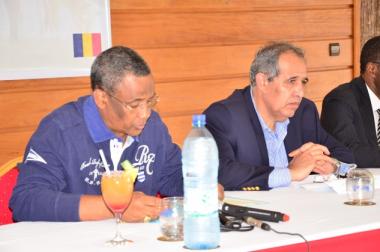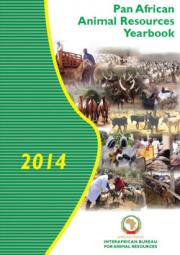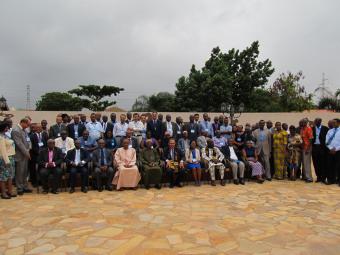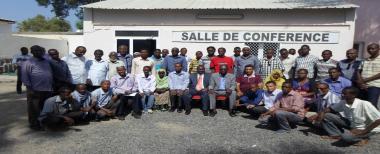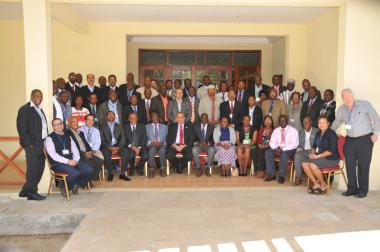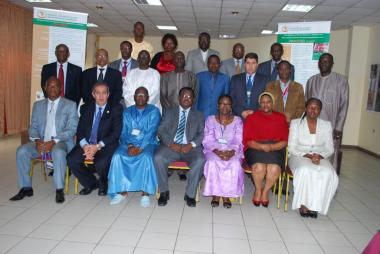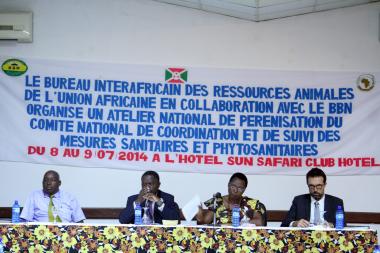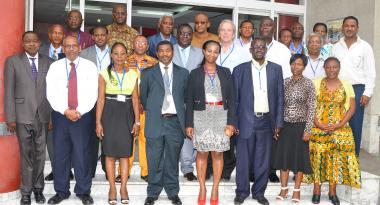Press Release
Nairobi, Kenya 5th February 2024
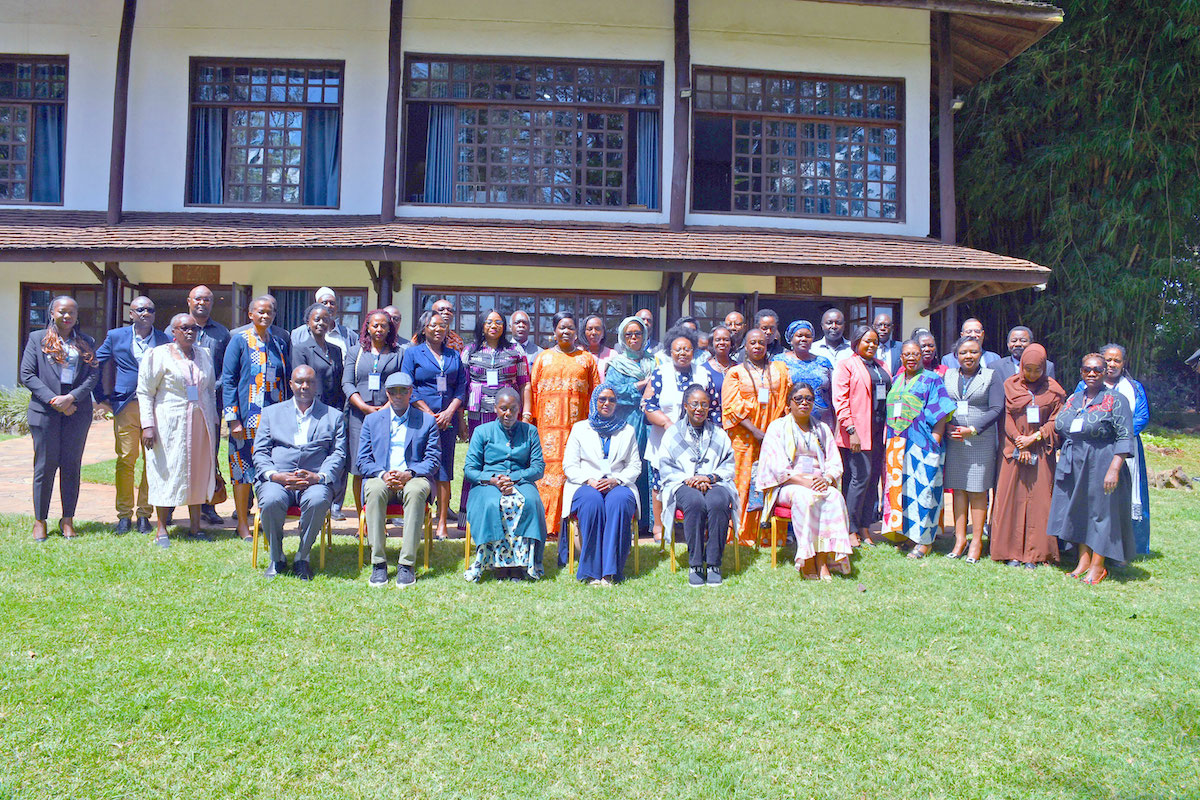
The African Union-InterAfrican Bureau for Animal Resources (AU-IBAR) Resilient African Feed and Fodder Systems Project (RAFFS) is this week holding a continental meeting with delegates from 6 African Union Member States to discuss and adopt strategies for a resilient sector.
The RAFFS Project is an initiative responding to the Triple C crises - Covid-19, Climate Change shocks, and the Russia-Ukraine conflict that have severely impacted African feed and fodder systems. The project aims to understand the effects of these crises and provide evidence-driven short-term solutions to build resilience in the sector.
Feed and fodder shortages have led to substantial livestock losses, eroded livelihoods, and increased prices of essential livestock-sourced foods. The project aims to strengthen knowledge and analytical ecosystem, identify innovative business models, engage more women, policy engagement and foster partnerships for coordinated action to address immediate challenges. Experts, government representatives, and stakeholders will this week discuss strategies, investment areas, distill information from the RAFFS survey and assessments to adopt strategies for a better feed and fodder sector to enhance food and nutrition security. The discussions aim to address the challenges faced by these countries and generate country work plans on their priority areas.
Since its rollout in January 2023, the RAFFS Project has achieved significant milestones. Key actions include the selection of six core countries (Cameroon, Kenya, Nigeria, Somalia, Uganda, and Zimbabwe), stakeholder identification, and a continent-wide survey and assessments to understand the status of the feed and fodder sector. The project has closely collaborated with the International Livestock Research Institute (ILRI) and other stakeholders to develop reports, integrate findings into the Comprehensive Africa Agriculture Development Programme (CAADP) 4th Biennial Review Report, and endorse urgent actions by the Specialized Technical Committee on Agriculture, Rural Development, Water, and Environment.
The survey and assessment reports, along with urgent actions endorsed by the Specialized Technical Committee, will be submitted to the African Union Heads of State and Government in early 2024. These documents will contain obligatory actions for African Union Member States to undertake in developing Africa's Feed and Fodder sub-sector.
The 6 countries have a population of close to 400 million people who face tremendous challenges that have profound implications for food and nutrition security. The availability of feed is a key factor in ensuring the well-being of livestock, and subsequently, food security for the country. All the countries have insufficient feed and fodder.
Kenya grapples with a staggering 60 % feed deficit, resulting in a significant shortfall of approximately 2.6 billion bales of feed. Furthermore, it faces a 46% post-harvest loss. The country is however, actively exploring multifaceted interventions aimed at boosting production, enhancing storage capabilities, and adding value to agricultural products. These efforts are pivotal in addressing food security concerns and advancing sustainable agricultural practices.
In Nigeria, high production costs, especially in poultry and aquaculture, pose a significant challenge. Ruminants, the majority of Nigeria's livestock, rely on communal grazing and crop residues, but these face issues of scarcity and security. Nigeria’s National Livestock Transformation Plan (NLTP) 2018-2028 seeks to enhance the feed and fodder system through strategies like sown pasture production. The National Agricultural Technology and Innovation Policy (NATIP) 2023-2028 also emphasizes technology and innovation for transformation.
Somalia has been grappling with the effects of its third consecutive below-average rainfall season since late 2020. Severe water and pasture shortages have resulted in emaciated livestock, excess livestock losses, limited livestock births, and significantly below-average milk production across all species. In pastoral livelihood zones in Southern, Central, and North. Eastern Somalia. Households continue to face challenges in affording food and water due to livestock production losses, high water and cereal prices, and conflict. This has led to emaciated livestock and significant livestock deaths, severely affecting both local and export markets.
The Zimbabwean livestock sector has a cereal livestock requirement of 450 000 MT which is usually not met due to mid-rain season dry spells, droughts, and insufficient inputs (seed, fertiliser, herbicides). The country is actively exploring multifaceted interventions aimed at boosting crop production, livestock feed and fodder production, enhancing storage capabilities, and adding value to agricultural products e.g. a fodder bank program with the target of producing 2 million hay bales per annum, silage production program with an annual target of 12,000ha under silage per season.
In Cameroon, The conflict between Russia and Ukraine has had significant implications specifically, the conflict has adversely affected food supply chains, leading to disruptions in production, sourcing, manufacturing, processing, and logistics. This disruption has had a direct impact on the supply of wheat, soybean, and maize, which are crucial materials for animal feed.
Uganda is facing a significant feed deficit, estimated at 50-70%. Yet, there is no formalized method for triggering a response to this emergency. Shifting this approach presents an opportunity to establish a more effective response system. There is a noticeable gap in linking feed and human nutrition. One critical issue raised is the lack of contractual mechanisms to enforce agreements in the feed and fodder sector. This lack of enforcement mechanisms hampers progress and accountability.
As of 2023, the continental goal of reducing stunting prevalence to 10 percent or less has not yet been attained. Among the 40 Member States that provided reports on stunting, only 7 are progressing as planned. These countries include Cabo Verde, Comoros, Ethiopia, Gabon, Mauritius, Seychelles, and Tunisia (with a prevalence of 0.01 percent). Additionally, four nations are showing improvement in their efforts to decrease stunting rates to 10 percent or less by 2025. These countries are Burkina Faso, Egypt, Kenya (with a prevalence of 17.6 percent), and Somalia (with a prevalence of 18.0 percent). This suggests that there is a need for greater commitment and action across the continent to improve the sector's status.
The following guidelines were developed in December by continental experts and will be adopted to support the countries in their implementation.
- Draft guidelines on data management framework and a platform for an integrated and harmonized multi-actor ecosystem.
- Profiles of feed and fodder commercialization and contracting models for the countries covered under the RAFFS Project.
- Profiles for investments and financing mechanisms and criteria for challenge funding for feed and fodder enterprises.
- Guidelines for the formation and operationalization of feed and fodder multi-stakeholder platforms for coordinated feed and fodder action in the project countries.
- Guidelines for Communication, Visibility and Knowledge management for the RAFFS project
Expected outcomes include: validated reports, endorsed guidelines, validated models for fodder production and contracting, and action plans at both country and continental levels.
AWARFA-N:
AWARFA-N was launched in July 2018, supported by the AU-IBAR and funded by the European Union. AWARFA-N consists of continental, regional, and national chapters, focusing on empowering women involved in animal resource value chains.
Critical issues faced by women in the livestock sector revolve around their constrained access to appropriate, long-term financing solutions tailored to their unique requirements. Women play pivotal roles in our society, serving as the bedrock for resilience through their functions in reproduction, nurturing, caregiving, and productivity. These multifaceted roles significantly contribute to individual, household, and community income, foster economic expansion, ensure food security, and enhance the well-being of children.
AWARFA- N seeks to enhance women's participation and benefits across animal resource value chains, including feed and fodder, women aspire to expand beyond subsistence livestock keeping into commercial ventures at various scales.
About AU-IBAR:
AU-IBAR operates as a technical office within the African Union Commission, with a core mission to support African Union member states in harnessing the potential of animals for human well-being and economic development. The organization plays a pivotal role in coordinating and advancing livestock development across the continent.
Note to Editors:
For additional information, please visit AU-IBARs website on RAFFS
For more information contact Dr. Sarah Ashanut Ossiya - sarah.ossiya@au-ibar.org
For media inquiries, please contact: Fiona Imbali- fiona.imbali@au-ibar.org

